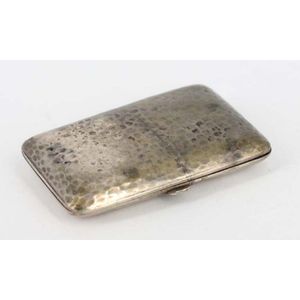1900 Chester Sterling Silver Monteith Bowl
You must be a subscriber, and be logged in to view price and dealer details.
Subscribe Now to view actual auction price for this item
When you subscribe, you have the option of setting the currency in which to display prices to $Au, $US, $NZ or Stg.
- Hallmarks - A mark stamped on articles of precious metals in Britain, since the 14th century, certifying their purity. It derives its name from the Guild Hall of the Goldsmiths' Company, who recieved its Charter in 1327 giving it the power to assay (test the purity) and mark articles of gold and silver.
The hallmark will consist of several marks, including the:
- silver standard mark, indicating the purity of the metal. Sterling silver is .925 pure silver.
- the city mark indicating the city in which it was assayed eg London, Birmingham, York etc.
- the date mark, usually a letter of the alphabet in a particular font and case,
- a duty mark, indicating whether duty had been paid to the crown, and only in use from 1784 to 1890
The piece may include an additional mark, the maker's mark, although not forming part of the hallmark, will be located in the vicinity of the hallmarks.
Sometimes silver plated items will bear faux hallmarks, often confusing those not familiar with silver markings. - Sterling Silver - Sterling silver is a mixture of 92.5% pure silver and 7.5% of another metal, usually copper. Fine silver is 99.9% pure silver, and is relatively soft and the addition of the very small amount of copper gives the metal enough strength and hardness to be worked into jewellery, decorative and household objects.
- Scallop / Shell Motif - The shell motif has been used in furniture and decorative arts for centuries. In ancient Greece and Rome, shells were often used as decorative elements on furniture and in mosaics. The scallop or cockleshell are the most commonly used. During the Renaissance, the shell motif became popular in furniture and architecture, as the ornate decoration was seen as a symbol of wealth and luxury. In the 18th century, the Rococo style of furniture and decorative arts featured an abundance of shell motifs, and it was used by Thomas Chippendale and as a feature on Queen Anne style cabriole legs. In the 19th century, the shell motif was incorporated into Victorian furniture and decorative items, and often a representation of the the conch shell was inlaid into furniture.
This item has been included into following indexes:
- bowls and dishes, silver
- monteith - silver items 12
Visually similar items

Alvar Aalto (Finnish, 1898-1976), Table 83, designed 1935, manufactured by Artek, birch, rectangular top above four L-shaped legs, together with Alvar Aalto H297 Filing Cabinet, manufactured by Artek, both items retain decal labels (2), height 70 cm, width

An Art Deco Danish silver cigarette case, beaten silver exterior, gilded interior, Christian F. Heise, Denmark, 1919.

A rare silver plate Asprey & Co cocktail shaker, The Thirst Extinguisher, circa 1932, in the form of a period fire extinguisher, the revolving base with eight cocktail recipes, stamped manufacturer's marks with number 3212S and REGD. NO. 833773, 40 cm high

A Moorcroft Pottery Queens Choice lamp, c.2005, designed by Emma Bossons, with Moorcroft issue shade. Height 74 cm
